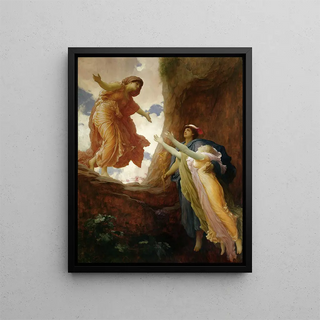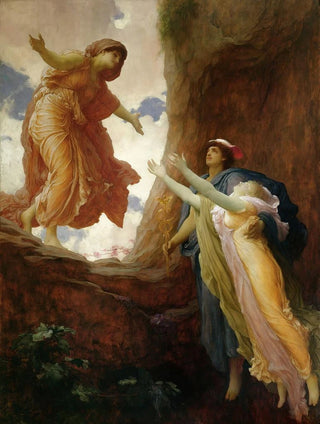Art print | The Return of Persephone - Frederic Leighton


View from behind

Frame (optional)
Reproduction Le Retour de Perséphone - Frederic Leighton – Captivating Introduction
The Return of Persephone, an iconic artwork by Frederic Leighton, embodies the perfect fusion of classical mythology and Victorian aesthetics. This painting, depicting the poignant moment of Persephone's return to the underworld after her visit to earth, evokes a rare emotional depth. The scene, rich in symbolism, reveals a tension between light and darkness, love and loss. In this mythological setting, Leighton manages to capture not only the physical beauty of his characters but also the complexity of their emotions, making this piece timeless and universal.
Style and uniqueness of the work
Leighton's style is distinguished by meticulous attention to detail and masterful use of color. In The Return of Persephone, the rich hues of red and gold blend harmoniously, creating an atmosphere that is both dramatic and lyrical. The drapery of the characters' clothing, with remarkable fluidity, testifies to the artist's technical virtuosity. Every fold, every shadow is carefully studied, adding a sculptural dimension to the painting. The composition, meanwhile, is skillfully orchestrated, guiding the viewer's gaze toward Persephone's face, whose melancholic expression is at the heart of the work. This ability to combine technique and emotion makes Leighton an undisputed master of the Pre-Raphaelite movement.
The artist and his influence
Frederic Leighton, an emblematic figure of the 19th-century artistic movement, mastered his style through a rich and varied body of work. Influenced by the great masters of the Renaissance, he was also shaped by the contemporary currents of his time. His fascination with mythology and ancient history is reflected in many creations, and The Return of Persephone is a perfect example. As president of the Royal Academy, he played a crucial role in promoting the arts in Great Britain, encouraging young artists to explore classical themes while incorporating modern sensibilities. His impact on British art is undeniable, and his legacy endures through generations of artists who continue to draw inspiration from his work.
A decoration

Matte finish

View from behind

Frame (optional)
Reproduction Le Retour de Perséphone - Frederic Leighton – Captivating Introduction
The Return of Persephone, an iconic artwork by Frederic Leighton, embodies the perfect fusion of classical mythology and Victorian aesthetics. This painting, depicting the poignant moment of Persephone's return to the underworld after her visit to earth, evokes a rare emotional depth. The scene, rich in symbolism, reveals a tension between light and darkness, love and loss. In this mythological setting, Leighton manages to capture not only the physical beauty of his characters but also the complexity of their emotions, making this piece timeless and universal.
Style and uniqueness of the work
Leighton's style is distinguished by meticulous attention to detail and masterful use of color. In The Return of Persephone, the rich hues of red and gold blend harmoniously, creating an atmosphere that is both dramatic and lyrical. The drapery of the characters' clothing, with remarkable fluidity, testifies to the artist's technical virtuosity. Every fold, every shadow is carefully studied, adding a sculptural dimension to the painting. The composition, meanwhile, is skillfully orchestrated, guiding the viewer's gaze toward Persephone's face, whose melancholic expression is at the heart of the work. This ability to combine technique and emotion makes Leighton an undisputed master of the Pre-Raphaelite movement.
The artist and his influence
Frederic Leighton, an emblematic figure of the 19th-century artistic movement, mastered his style through a rich and varied body of work. Influenced by the great masters of the Renaissance, he was also shaped by the contemporary currents of his time. His fascination with mythology and ancient history is reflected in many creations, and The Return of Persephone is a perfect example. As president of the Royal Academy, he played a crucial role in promoting the arts in Great Britain, encouraging young artists to explore classical themes while incorporating modern sensibilities. His impact on British art is undeniable, and his legacy endures through generations of artists who continue to draw inspiration from his work.
A decoration






